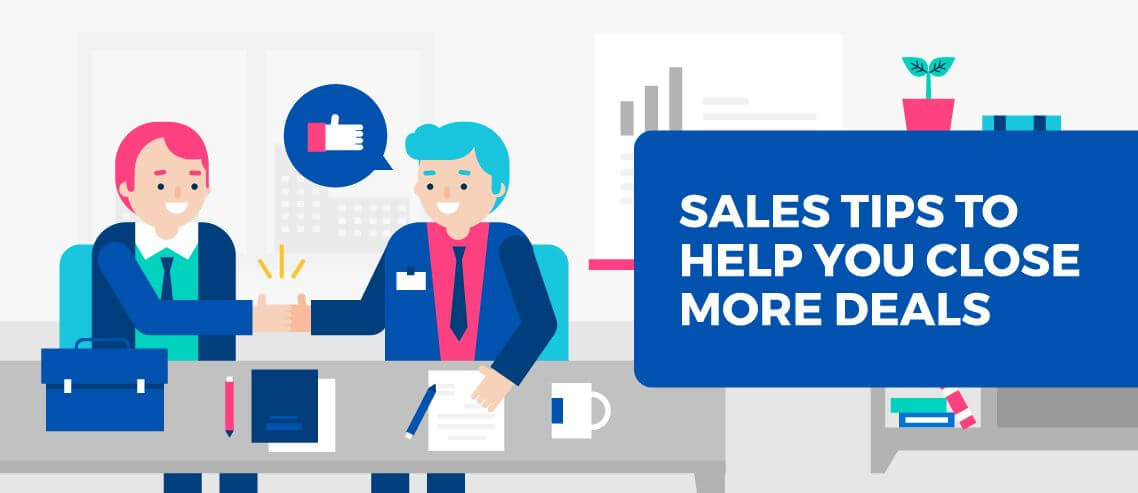5 Sales Tips to Help You Close More Deals

Contents
Are you tired of being told to “dive into customer personas?”
The stream of content online telling you how to close more deals and win more revenue for your company is endless. But let’s be honest, you’re already racing against the clock to get more done, right?
And you’re probably swamped with a laundry list of sales tips that seem effective, but demand time that you don’t have spare.
You need quick wins that work, like yesterday. And in this post, you’re going to get them. Keep reading for 5 quick sales tips that tilt the odds of closing in your favor without costing more than 5 minutes of your time.
Use the “so what?” test to transform your pitch
A feature is just a detail about your product. A benefit, however, shows how that feature will help your prospect. Make sure you’re selling features over benefits by using the “so what?” sales copywriting test.
Simply go through the list of features/facts for your product and ask yourself: “So what?”
It sounds simple, but this is a great way to sell better by putting yourself into your prospect’s shoes.
Imagine you’re pitching prospects a web intelligence tool, like Leadfeeder, here’s how the “so what?” test transforms your pitch:
- Our tool shows you which companies visit your website
- You can also use our trial “Lite” version for free
After using the “so what?” test, you communicate in a way that conveys value:
- By showing you which companies visit your site, our tool lets you generate more leads quickly
- Using the “Lite” version, you can generate leads without paying for them
That’s a huge difference in persuasiveness, don’t you think?
If you haven’t tried the “so what” test already, give it a shot. List all the important facts and features about your product/service, then convert each feature into a benefit by putting yourself in your prospect’s shoes and asking “so what?”.
Record your calls to reveal “golden” sales data
If you’re not recording sales calls, you’re losing precious, easy to capture sales data.
Calls and meetings play a critical role in the buyer journey. They are an opportunity to understand who your prospect is, what their unique challenges are, and most importantly, how your product helps them conquer those challenges.
By recording calls, you quickly store, capture and validate all the information above. This gives you a deeper insight into who you’re selling to, which can be used to quickly fine-tune your pitch and present your product in a way that appeals to your prospect.
With the right technology, tracking calls and meetings is easy. Start by using the Sales Navigator mobile app to log call length, duration, and the relevant LinkedIn contact that you’re connected to.
This will make follow-up conversations much smoother because you don’t have to leave the LinkedIn app.
If you want to take this further, consider an external call tracking/deal intelligence software like Gong.io.

Ask a question to start kickstart outreach
Asking questions is a powerful persuasive tactic because it provokes a response from the person on the receiving end.
In sales, the not so obvious benefit of asking questions is that you can instantly build rapport with a prospect by subtly showing that you know or understand them. Some rapport-building questions you can ask to do this are:
- I saw your post on LinkedIn about your new role in [xyz company]. Congratulations! How is it going so far?
- I see that you’ve studied [subject] at [college name], how was it?
- I see you’ve been a [job role] at [prospect’s company name] for 5 years? Wow. How did you manage to get that far so quickly?
A good question triggers a warm flash of recognition and invites your prospect to talk. If they respond (they should if you asked the right question), you can follow them up and steer the conversation towards your pitch.
Boost your social selling score index
LinkedIn describes the Social Selling Index (SSI) as a “measure of a company’s or individual’s adaptation of the four pillars of selling on LinkedIn, based on a scale of 0 to 100.”
In”human-speak”, this means that it measures your ability to communicate your personal brand, network with other professionals, and interact with relevant leads who care about your product/service.
Boosting your social selling score has exponential benefits. A higher score means you appear more credible to current prospects, and at the same time, more visible to those who are new.
You can increase your social selling score relatively quickly. All you have to do is improve on the “pillars of social selling” that LinkedIn uses to calculate your score. Here’s what you should work on:
- Personal branding: On your profile page, use the language that your prospects use. Include a compelling image and banner, and link to your work/website.
- Reach out to targeted prospects: Limit cold connection requests. Instead, send warm requests to leads who view your profile or have mutual connections.
- Interact with others in your industry: Simply share and interact with timely and topical content in your industry. This shows LinkedIn that you provide value and engage with others in your field.
5. Use competitors to sell your product
Talking about competitors is a touchy subject.
When the topic arises during a conversation, some reps resort to bashing the competition. Others act as if they don’t actually exist. Neither of these extremes is ideal.
While you should avoid bashing competitors, acting as if you don’t have any only makes you appear aloof and arrogant. So what should you do instead?
Embrace the fact that you have competition, and use it to your advantage.
Ask your prospect if they are interacting with another company or rep (this is highly likely). If the answer is “yes”, throw in a kind word and use your key USPs to explain how you’re different from competitors.
If the answer is “no”, you can still bring up your USPs preemptively or just continue the conversation.
This displays confidence in your product, communicates your USPs, and does some of the research/comparisons work your prospect has done or will inevitably do.
Close more deals and waste less time
In sales, every pitch, call, conversation, and request is an opportunity to deliver value and win more revenue. But improving your ability to perform in each of these areas is tricky.
With the 5 pack-a-punch quick sales tips above, you don’t need to be an enlightened sales productivity guru to up your game. You avoid the rabbit hole of endless sales advice abundant on the internet and instead, focus on tweaks to your selling game that deliver big wins in revenue.





